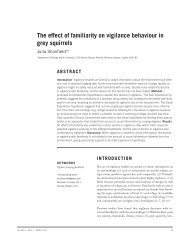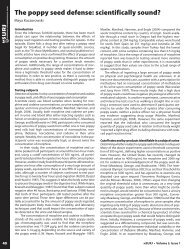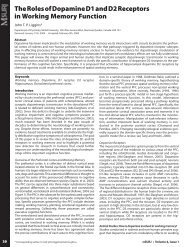the entire issue - McGill Science Undergraduate Research Journal ...
the entire issue - McGill Science Undergraduate Research Journal ...
the entire issue - McGill Science Undergraduate Research Journal ...
You also want an ePaper? Increase the reach of your titles
YUMPU automatically turns print PDFs into web optimized ePapers that Google loves.
Neuronal spiking is better than bursting at predicting motion detection in area MT<br />
synaptic neuron. Hence, bursting in a V1 neuron can encode more<br />
relevant information than isolated spikes in a V1 neuron, which is<br />
more indicative of noise (2).<br />
The middle temporal visual area (MT), an area of extrastriate visual<br />
cortex, plays an important role in visual processing. A major input to<br />
this region is a magnocellular-dominated projection from layer 4B<br />
of V1. The MT visual area also receives projections from V2 and V3<br />
- which are downstream of V1 - and directly from <strong>the</strong> lateral geniculate<br />
nucleus. Each MT neuron is tuned to a particular receptive field,<br />
and selective for a motion direction and speed to which it responds<br />
most vigorously. Area MT projects to downstream regions such as<br />
<strong>the</strong> ventral intraparietal area (VIP) and <strong>the</strong> medial superior temporal<br />
(MST) area (6). The MT region is crucial in motion perception,<br />
control of eye movements, and in integration of motion signals into<br />
a general perception (6). Since bursting has been shown to play an<br />
important role in V1, this paper looks at whe<strong>the</strong>r bursting also plays<br />
a role in area MT.<br />
In this paper, we will explore two research ideas with respect to neuronal<br />
activity in area MT. Firstly, we will determine which bursting<br />
parameter for neurons in area MT is most predictive of detecting coherent<br />
motion. Secondly, we will compare <strong>the</strong> average spiking rate<br />
and bursting of neurons in area MT and determine which of <strong>the</strong> two<br />
is more predictive of motion detection in Macaca mulatta (macaque)<br />
monkeys.<br />
were trained to maintain a fixation point on <strong>the</strong> screen, and release<br />
a lever for a juice reward if <strong>the</strong>y correctly detected coherent motion.<br />
A trial was considered correct only if <strong>the</strong> monkey released <strong>the</strong> lever<br />
within a window of 200-800 ms after coherent motion turned off, and<br />
incorrect in every o<strong>the</strong>r instance. All trials were organized into two<br />
groups for analysis: correct and incorrect. We analyzed <strong>the</strong> electrophysiological<br />
data based on <strong>the</strong> 100 ms time window after coherent<br />
motion was turned off.<br />
Fig. 2<br />
This is a graph of <strong>the</strong> presented stimulus on a timeaxis. There are<br />
four times that are important for this experiment:<br />
1) onset of random motion - this is when <strong>the</strong> RDP is presented to a<br />
neuron’s receptive field at time 0<br />
2) coherence on – this denotes when coherent motion is presented<br />
in a receptive field<br />
3) coherence off – this denotes when <strong>the</strong> coherent motion stops<br />
4) <strong>the</strong> 100 ms after coherence off – this was used for analysis.<br />
Methods<br />
Behavioural Task<br />
Dr. Cook’s lab trained two macaques to detect coherent motion while<br />
connected to tungsten microelectrodes, which recorded <strong>the</strong>ir neuronal<br />
spiking activities. Each experiment used one monkey, and each<br />
experiment consisted of a varying number of trials. Each trial recorded<br />
<strong>the</strong> activity of two different neurons, neuron 1 and neuron<br />
2, from <strong>the</strong> same hemisphere of <strong>the</strong> monkey in question. Data was<br />
obtained from 19540 trials over <strong>the</strong> course of 50 experiments. The lab<br />
determined <strong>the</strong> location of each neuron’s receptive field, along with<br />
its preferred speed, orientation, and direction of stimulus before <strong>the</strong><br />
beginning of an experiment. Then, Random Dot Patches (RDP) were<br />
presented to that neuron’s receptive field with increasing coherence,<br />
starting at 0% and adhering to <strong>the</strong> neuron’s preferences.<br />
There were three conditions in each trial. Condition 1 represented<br />
coherent motion in <strong>the</strong> receptive fields of both neuron 1 and neuron<br />
2. Condition 2 presented coherent motion only in <strong>the</strong> receptive field<br />
of neuron 1. Condition 3 presented coherent motion only in <strong>the</strong> receptive<br />
field of neuron 2. Anywhere between 500 and 10,000 ms after<br />
<strong>the</strong> onset of RDP presentation, <strong>the</strong> RDP was presented with coherent<br />
motion in <strong>the</strong> receptive field(s) for 50 ms (Fig. 2). The monkeys<br />
Analysis of Data<br />
We used a time period of 100 ms for our analysis because previous<br />
studies have reported that neural–behavioural covariation is greatest<br />
for this time window (7) . We used values for <strong>the</strong> standard area under<br />
<strong>the</strong> receiving operator characteristic curve (aROC) to determine <strong>the</strong><br />
probability of motion detection that is correlated to a specific bursting<br />
parameter or to a spiking activity. If an aROC value of 0.5 is returned,<br />
this suggests that <strong>the</strong>re is no correlation between <strong>the</strong> number<br />
of correct trials and <strong>the</strong> neuronal activity in question. However, aROC<br />
values greater or less than 0.5 suggest a greater predictive capacity<br />
(8) and correlation between <strong>the</strong> number of correct trials and neuronal<br />
activity. What matters is not whe<strong>the</strong>r <strong>the</strong> aROC value is greater or<br />
less than 0.5, but <strong>the</strong> absolute difference between <strong>the</strong> aROC value and<br />
0.5 (ie. aROC values of 0.6 and 0.4 have an equal predictive capacity).<br />
The higher <strong>the</strong> absolute difference between 0.5 and <strong>the</strong> aROC value,<br />
<strong>the</strong> higher <strong>the</strong> predictive capacity (8). The bursting parameters we<br />
used varied from 1 – 5 spikes for 10 – 100 ms with 10 ms steps.<br />
In order to produce aROC values for <strong>the</strong> different bursting parameters,<br />
we first calculated <strong>the</strong> distribution of <strong>the</strong> number of bursts<br />
within <strong>the</strong> 100 ms time period after coherence was turned off for<br />
both correct trials and incorrect trials averaged over both neurons in<br />
condition 1. We inputted <strong>the</strong>se distributions into <strong>the</strong> MATLAB function<br />
detect probability, which outputted an aROC value. This function<br />
40<br />
<strong>McGill</strong> <strong>Science</strong> <strong>Undergraduate</strong> <strong>Research</strong> <strong>Journal</strong> - msurj.mcgill.ca









